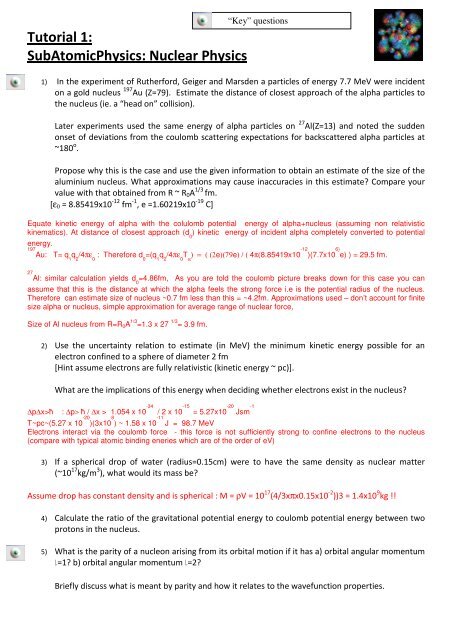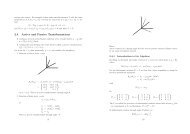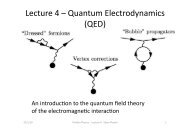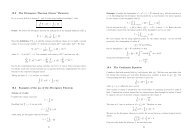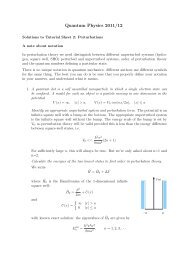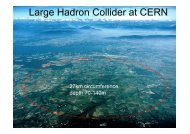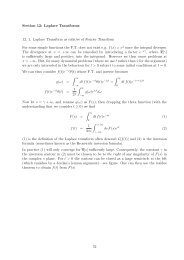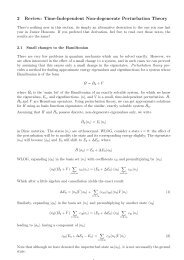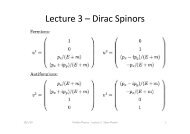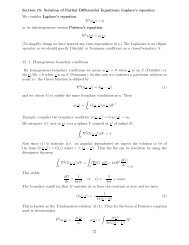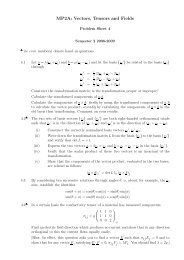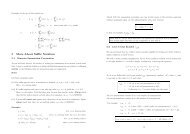Tutorial 1: SubAtomicPhysics: Nuclear Physics
Tutorial 1: SubAtomicPhysics: Nuclear Physics
Tutorial 1: SubAtomicPhysics: Nuclear Physics
Create successful ePaper yourself
Turn your PDF publications into a flip-book with our unique Google optimized e-Paper software.
7. The atomic mass of a nucleus is predicted by the semi-empirical mass formula to be given byM(N,Z)c 2 = ZM H c 2 + NM n c 2 - a v A + a s A 2/3 + a c Z 2 /A 1/3 + a sym (N-Z) 2 /A + δWhere M H = 938.8 MeV/c 2 , M n = 939.6 MeV/c 2 , a v = 15.8 MeV, a s = 18.0 MeV, a c = 0.7 MeV anda sym = 25.3 MeV.Mirror nuclei are nuclei with the same mass number A and interchanged values of N and Z. Whichterms in the above formula give rise to differences in atomic mass between a pair of mirror nuclei?Calculate the predicted atomic mass difference between 11 C(Z=6) and 11 B(Z=5) in units of MeV/c 2 .From this information and any general considerations, what can you deduce about the possible decaymodes for these two nuclei?Mirror nuclei have the same value of A but interchanged values for N,Z. The only terms in the SEMF which survive when takingthe mass difference between mirror nuclei is the ZM Hc 2 , NM nc 2 and a cZ 2 /A 1/3 .∆Mc 2 = M( 11 B)-M( 11 C) = (Z 1 -Z 2 )M H c 2 + (N 1 -N 2 )M n c 2 + a c /A 1/3 (Z 1 2 -Z 2 2 )Using given values of Z aand masses gives ∆Mc 2 ) = -2.66 MeVDifference shows 11 B more stable than 11 C.11 C will decay to 11 B by β + emission8. In the semi-empirical mass formula what experimental evidence does the pairing term δ account for?For a given value of the mass number A, nuclear masses can be expressed as a quadratic function inZ. Using the “minimum isobar” formula (as derived in the lecture notes) determine whether the142 Xe(Z=54) is β + or β - unstable.Pairing term accounts for the observational evidence that even-even nuclei are more stable than odd-odd nuclei. It has a quantummechanical origin and reflects the extra binding felt by paired nucleons (with opposite spins) which can share the same spatialstates, increasing their probability to be in close proximity to each other and feel the strong force.From formula derived in the notes Z stable = 142 / 1.972 + 0.015(142) 2/3 = 60Therefore 142 Xe(Z=54) will decay by β - towards the stable nucleus at Z=60<strong>Tutorial</strong> 3:<strong>SubAtomic<strong>Physics</strong></strong>: <strong>Nuclear</strong> <strong>Physics</strong>1) A neutron star can be crudely approximated as a large assembly (>~10 55 ) of neutrons. Use the semiempirical mass formula to estimate the binding energy per nucleon of a neutron star (you mayneglect the δ term). Comment on the physical implications of the value obtained.Which additional term should also be included in the mass formula if it is to be extrapolated toneutron stars? Propose a form for this extra term.Yhe expression for the binding energy per nucleon (note you get this by dividing the formula for the binding energy (B) given inthe notes by A!!)B/A = a v – a s A -1/3 – a c Z 2 /A 4/3 –a s (A-2Z) 2 /A 2As A is very large the surface and coulomb terms are negligible. The B/A is determined by the difference between the volumeterm and the asymmetry term. The latter approaches if we assume the star is dominantly neutrons i.e. A>>ZB/A = a v - a s = 15.6 – 23.3 MeV = -7.7 MeV. The expression is negative implying the system is unbound. Therefore to bind a starother forces contribute. For a large object such as this the gravitational effects cannot be neglected. An attractive gravitationalpotential energy term should be added to the SEMF. The form will be similar to the derivation of the coulomb potential term inthe lectures. i.e. (3/5) (G/r o ) (M 2 /A 1/3 ). Using this term you can go on to calculate the minimum size needed for a stable star !!2) Use the semi empirical mass formula to calculate the energy released when 238 U fissionssymmetrically. Propose why fission products are often unstable.
Fission process total nucleons remain the same. Terms dependent on A only will not contribute.∆Mc 2 = [M( 238 U)- 2*M( 119 Pd)]c 2 = [ZM H + NMn – B( 238 U)/c 2 – 2*(Z 1 M H + N 1 Mn –B( 119 Pd)/c 2 )In symmetric fission Z 1 =Z/2 . Therefore using the SEMF.= 2* B( 119 Pd)/c 2 - B( 238 U)/c 2 = [2*(1856.4 – 416.13 – 301.13 – 142.74 + 0) – (3712.8 – 660.56 – 956.05 – 285.47 + 0.77) =181 MeVNote the differences in the SEMF terms for the 2 nuclei.Fission products are often unstable as you have gone from a heavy nucleus where the most stable configuration favours a largeneutron excess, to a lighter nucleus where the most stable configuration has smaller (or zero) neutron excess. Therefore the fissionfragments tend to have an excess of neutrons compared to the stable configuration and are unstable.3) Work out the spin and parity of the ground states of a) 16 O(Z=8) b) 15 N(Z=7) c) 23 Na (Z=11) in termsof the nuclear shell model.4) Give possible shell model nucleon configurations which could produce the 5/2 + , 1/2 + , 1/2 - , 5/2 - ,3/2 - and 3/2 + excited states of 17 O(Z=8)5) 208 Pb(Z=82) has a closed 3p 1/2 sub-shell of neutrons and a closed 3s 1/2 shell of protons. In terms ofthe shell model what spin and parity is expected for ce ground state of 207 Pb and 207 Tl(Z=81).207 Pb 1 unpaired neutron in the 3p 1/2 level. Therefore J π =1/2 -207 Tl 1 unpaired proton in the 3s 1/2 level. Therefore J π =1/2
6) In odd-odd nuclei, an interaction between the last odd neutron and the last odd proton must be takeninto account in order to explain the ground state spins. The coupling favours parallel spins of the oddproton and the odd neutron. On this basis determine the ground state spin and parity for the 14 N(Z=7) nucleus, giving a sketch of the occupation of levels as prescribed by the shell model.7) The rotational model for permanently deformed nuclei predicts excitation energies given byE(J)=J(J+1)ħ 2 / 2I with J=the spin of the nuclear state and I=moment of inertia of the nucleus aboutthe axis of rotation. The energies and spins of the first two excited states of 180 Hf areEnergy (MeV) J0.093 20.309 4Determine whether these values agree with the rotational model and if soa) Predict the energy of the third excited state (J=6) andb) Calculate the moment of inertia for the nucleus (ħ =6.582x10 -22 MeVs)<strong>Tutorial</strong> 4:<strong>SubAtomic<strong>Physics</strong></strong>: <strong>Nuclear</strong> <strong>Physics</strong>1) Calculate the Q value for 228 Th(Z=90) (mass=228.0287u) to emita) An α particleb) A protonFor the first case calculate the kinetic energies of the alpha particle and the daughter nucleus.224 Ra(Z=88) = 224.0202u; 227 Ac(Z=89) = 227.0278u]α emission Q α = [ M(A,Z) – M(A-4,Z-2) - M( 4 He) ] c 2 = [0.059u]c 2 As 1u = 931.494 MeV/c 2Q α =[0.059u] (931.494 MeV/u = 5.496 MeVQ value is energy released in α decay of 228 Th. This will be split between the daughter and the alpha.
T α = (A-4/A)Q α = (228-4/228)Q α = 5.4 MeVProton emission Q p= [ M(A,Z) – M(A-1,Z-1) - M( 1 H) ] c 2 = - 6.45 MeVQ p value negative so energy required to remove a proton from 228Th .For many heavy nucei alpha particles are preferentially emitted over protons, detuterons, tritons as the 2n-2p configuration os verytightly bound (e.g. See BE/A curve). Therefore, as can be seen in the above example, alpha emission can proceed spontaneouslywith a release of energy whereas the other decay modes would require an input of energy.2) Can 57 Co(Z=27) spontaneously decay by β + emission ?[masses:57 Co= 56.936294u; 57 Fe =224.0202u; 2m e = 0.001097u]Q β+ = [ M(A,Z) – M(A,Z-1) – 2m e] c 2= [56.936294u-56.935396u-2(0.001097)u]c 2 = -0.185 MeVQ
5) The ground state of 8 4Be is unstable and decays into two alpha particles ( 4 2He) with a half lifeτ 1/2 =1.0x10 -16 s. Determine the relative orbital angular momentum of the two alpha particles andestimate the particle decay width (eV) of the 8 4Be ground state.6) The nuclide 12 N(Z=7) decays by β + emission with a maximum positron energy of 16.316 MeV.Calculate the neutral atomic mass of the parent atom.7) Which of the following heavy nuclei would you expect to have large cross sections for reactions withthermal neutrons?a) 251 Cf (Z=98) b) 255 Fm (Z=100) c) 250 Bk (Z=97) d) 238 U(Z=92)Fissile nuclei have large thermal neutron cross sections. These are even-odd or odd-odd. The addition of theneutron to a fissile nucleus results in an energy benefit from the pairing energy which allows even thermalenergy neutrons to have an appreciable probability to induce fission. Nuclei a) b) and c) are fissile


